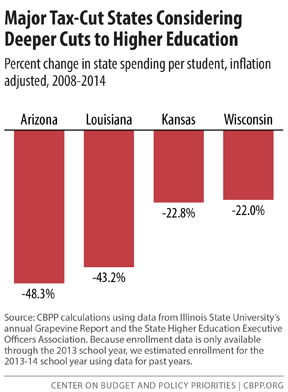BEYOND THE NUMBERS
With the recession behind them, many states are reinvesting in their higher education systems, though funding remains far below pre-recession levels. A handful of states, however, have dug deeper budget holes with tax cuts — holes that they’re looking to their already beleaguered colleges and universities to help them fill. For example:
- No state cut higher education funding more deeply between 2008 and 2014 than Arizona, which reduced inflation-adjusted per-student spending by almost 50 percent. State lawmakers earlier this month passed a budget that further cuts higher education funding by nearly $100 million — including eliminating state support for community colleges in the state’s most populous counties. Arizona enacted large corporate tax cuts in 2011 — in addition to other smaller cuts over a longer period of time — that are beginning to phase in.
- Over the same period, Louisiana slashed per-student funding for higher education by 43 percent, second only to Arizona. Due largely to poor budgeting choices, the state faces a $1.6 billion shortfall in the upcoming fiscal year, which the governor plans to cover in part by cutting higher ed funding by another $211 million. The state’s finances would be in much better shape if it didn’t enact costly income tax cuts for the state’s highest earners just before the recession.
- In Wisconsin, where tax cuts have cost the state nearly $2 billion in revenue over the past four years, lawmakers are considering another $300 million cut to the higher education system in the 2016 budget. Wisconsin has already cut per-student funding more than 20 percent, in inflation-adjusted terms, since the onset of the recession.
- In Kansas, lawmakers actually increased higher education spending for the 2014-15 school year. However, due to a fiscal emergency caused by massive tax cuts that took effect two years ago, Governor Sam Brownback pared back the increase by $16 million, among other mid-year cuts. Between 2008 and 2014, after adjusting for inflation, the state had cut per-pupil funding by about 23 percent. Kansas is facing another huge budget gap for 2016, so more cuts for higher education and other state services likely are on the way.
These cuts may result in more tuition increases, reductions in faculty and administrative staff, cuts to course offerings, and other programmatic cuts that may lessen quality for students. As the economy continues to recover and revenues bounce back, states would do well to reject costly and ineffective tax cuts and instead reinvest additional resources into higher education and other important budget priorities.

